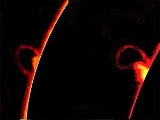
Solar flare
Overview
A solar flare is a sudden brightening observed over the Sun
Sun
The Sun is the star at the center of the Solar System. It is almost perfectly spherical and consists of hot plasma interwoven with magnetic fields...
surface or the solar limb, which is interpreted as a large energy release of up to 6 × 1025 joule
Joule
The joule ; symbol J) is a derived unit of energy or work in the International System of Units. It is equal to the energy expended in applying a force of one newton through a distance of one metre , or in passing an electric current of one ampere through a resistance of one ohm for one second...
s of energy
Energy
In physics, energy is an indirectly observed quantity. It is often understood as the ability a physical system has to do work on other physical systems...
(about a sixth of the total energy output of the Sun each second). The flare ejects clouds of electrons, ions, and atoms through the corona into space. These clouds typically reach Earth
Earth
Earth is the third planet from the Sun, and the densest and fifth-largest of the eight planets in the Solar System. It is also the largest of the Solar System's four terrestrial planets...
a day or two after the event.

